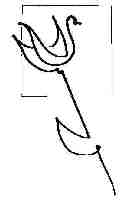
Dr.
Norman Allan's
Newsletter
Vol 2,
No. 4,
April 2006

 |
Dr.
Norman Allan's Vol 2,
No. 4, |
 |
|
*
newspaper clippings
! |
||
|
* * *
|
||
| Again,
the bulk of this newsletter is made up of items I've seen in the press,
related to health, that you might have missed, that I found interesting.
It's also an opportunity for me to remind you of my open house on Thurs. from 3 to 6 pm. (Treatment is available, by donation, at the Open House.) |
||
|
* * *
|
||
|
The Safety of Aspartame "... new alarm was raised by a large study in laboratory rats conducted at the European Ramazzine Foundation in Italy. The study found a statistically significant increase in lymphomas, leukemias and other cancers in rats that were fed aspartame for a lifetime and compared with rats that were not. Excess cancers were found even in rats fed doses equal to 20 milligrams per kilogram of body weight, well below the 50 milligram level currently deemed acceptable for humans in the United States. [recall here the item in January's newsletter: "Combining food additives may be harmful, say researchers" (Guardian, 21 Dec 2005 ) "Researchers
at the University of Liverpool ... reported that when mouse nerve cells
were exposed to MSG and brilliant blue or aspartaine (Nutrasweet) and
quinoline yellow in laboratory conditions, combined in concentrations
that theoretically reflect the compound that enters the bloodstream
after a typical children's snack and drink, the additives stopped the
nerve cells growing and interfered with proper signaling systems. The
mixtures of the additives had a much more potent effect on nerve cells
that each additive on its own." ... |
||
|---|---|---|
|
* * *
|
||
|
Wireless
Frequencies as Pollution "According
to stats from sweden and Briton, about 2 or 3 percent of the population
suffers from potentially debilitating electro-hypersensitivity, or EHS.
Symptoms are all over the map and include nausea, headache, chronic
fatigue, chronic pain, tinnitus and rashes, to name a few." (I
think that this list includes all the most common symptoms.) |
||
|
* * *
|
||
|
Record
Sales Of Sleep Pills cause Worry "About
42 million sleeping pill prescriptions were filled last year ... up nearly
60% since 2000... Sleeping Pill Wars |
||
|
* * *
|
||
|
"... Studies sponsored by the National
Eye Institute found that daily consumption of a high-dose formula of antioxidants
and zinc could reduce the risk that early macular degeneration
would advance. ..."
New York Times, 28 February 2006 |
||
|
* * * |
||
|
"Studies suggest
B Vitamins Don't Prevent Heart Attack" Actually, we are talking folic acid, B12 and B6 here. This combination of vitamins reduces blood levels of homocysteine. High blood levels of homocysteine correlate with the incidence of heart attack (it is a "risk factor). However, recent studies showed "no clinical benefit of the use of folic acid and vitamin B12 (with or without vitamin B6) in patients with established vascular disease." Homocysteine
is an amino acid, but is is not found in proteins. It is an intermediary
substance in the transition of the two sulphur containing amino acids,
methionine and cysteine, when the body changes the one into the other.
"Homocysteine
is a variant of the amino acid cysteine, differing in that its side-chain
contains an additional methylene (-CH2-) group before the thiol (-SH)
group.Homocysteine is formed from S-adenosyl methionine by a two step
reaction pathway. It can be converted back to methionine, or converted
to cysteine or taurine via the transsulfuration pathway." (source
http://en.wikipedia.org/wiki/Homocysteine) |
||
|
* * * |
||
|
* * *
|
||
|
Dr. Norman Allan's Newsletter, March 2006: snippets from newspapers, various, which I hope are of interest. Dr. Norman Allan's Newsletter, February 2006: as above Dr. Norman Allan's Newsletter, January 2006: Dr. Norman Allan's Newsletter, December 2005: Dr. Norman Allan's Newsletter, November: 2005 Dr. Norman Allan's Newsletter, October: 2005 Dr. Norman Allan's Newsletter, August/September: 2005 Dr. Norman Allan's Newsletter, June/July 2005: Dr. Norman Allan's Newsletter, May 2005: Dr. Norman Allan's Newsletter, March/April 2005: an essay on immune tonics published in "Healthy Directions" - and snippets from newspapers, various, which I hope are of interest. Dr.
Norman Allan's Newsletter, February 2005: snippets from newspapers,
various, which I hope are of interest - and a discussion of "C Reactive
Protein" as an indicator of risk for heart disease. |
||
|
* * *
|
||
| Not new, but still noteworthy:- | ||
|
visit
Dr. Allan's home page at
www.normanallan.com |
||